Benacian Union Defence Force: Difference between revisions
Continuator (talk | contribs) |
Continuator (talk | contribs) m (→Vessels) |
||
| Line 394: | Line 394: | ||
|[[Carrillo-class amphibious command ship]]|| {{team flag|Nouvelle Alexandrie|name=Pontecorvo Firm}} ||Amphibious command ship||2||[[image:Carrillo-class-amphibious-command-ship.jpg|250px]]||{{Unbulleted list|Out of service by {{AN|1748}}.}} | |[[Carrillo-class amphibious command ship]]|| {{team flag|Nouvelle Alexandrie|name=Pontecorvo Firm}} ||Amphibious command ship||2||[[image:Carrillo-class-amphibious-command-ship.jpg|250px]]||{{Unbulleted list|Out of service by {{AN|1748}}.}} | ||
|- | |- | ||
|[[Cartagena-class expeditionary mobile base|Cartagena-class]]||{{team flag|Nouvelle Alexandrie|name=Pontecorvo Firm}}||Expeditionary mobile base||1||[[File:Cartagena-class-expeditionary-mobile-base.jpg|250px]]||Order placed {{AN|1730}} | |[[Cartagena-class expeditionary mobile base|Cartagena-class]]||{{team flag|Nouvelle Alexandrie|name=Pontecorvo Firm}}||Expeditionary mobile base||0 / 1||[[File:Cartagena-class-expeditionary-mobile-base.jpg|250px]]||Order placed {{AN|1730}} | ||
|- | |- | ||
|[[Coastal Patrol Boat]]|| {{team flag|Sathrati|name=Amity Shipyards}}||Patrol||109||[[File:Coastal patrol boat.png|250px]]||{{unbulleted list|9x received from the [[Navy of Ransenar]] ({{AN|1712}})|Assigned to riverine duties.|Out of service by {{AN|1740}}.}} | |[[Coastal Patrol Boat]]|| {{team flag|Sathrati|name=Amity Shipyards}}||Patrol||109||[[File:Coastal patrol boat.png|250px]]||{{unbulleted list|9x received from the [[Navy of Ransenar]] ({{AN|1712}})|Assigned to riverine duties.|Out of service by {{AN|1740}}.}} | ||
| Line 400: | Line 400: | ||
|[[Dredger-class gunboat]]||{{Team flag|Benacian Union|name=Vijayanagara Fleet Construction Yards}}||Gunboat||9||[[file:Dredger-class monitor.png|250px]]||Order placed {{AN|1723}}. | |[[Dredger-class gunboat]]||{{Team flag|Benacian Union|name=Vijayanagara Fleet Construction Yards}}||Gunboat||9||[[file:Dredger-class monitor.png|250px]]||Order placed {{AN|1723}}. | ||
|- | |- | ||
|[[Ignatius-class amphibious transport dock|Ignatius-class]]||{{team flag|Nouvelle Alexandrie|name=Pontecorvo Firm}}||Amphibious transport dock ||10||[[File:Ignatius-class-amphibious-transport-dock.jpg|250px]]||{{unbulleted list|Order placed {{AN|1730}}|To replace the [[Logistic Support Vessel]].}} | |[[Ignatius-class amphibious transport dock|Ignatius-class]]||{{team flag|Nouvelle Alexandrie|name=Pontecorvo Firm}}||Amphibious transport dock ||0 / 10||[[File:Ignatius-class-amphibious-transport-dock.jpg|250px]]||{{unbulleted list|Order placed {{AN|1730}}|To replace the [[Logistic Support Vessel]].}} | ||
|- | |- | ||
|[[Manco Cápac-class cruiser]]||{{team flag|Nouvelle Alexandrie|name=ESB Armada}}||Frigate||40 / 120||[[File:1720 Manco Cápac-class auxiliary cruiser.png|250px]]||Order placed {{AN|1720}}. | |[[Manco Cápac-class cruiser]]||{{team flag|Nouvelle Alexandrie|name=ESB Armada}}||Frigate||40 / 120||[[File:1720 Manco Cápac-class auxiliary cruiser.png|250px]]||Order placed {{AN|1720}}. | ||
Revision as of 06:03, 25 March 2024
| Benacian Union Defence Force | |
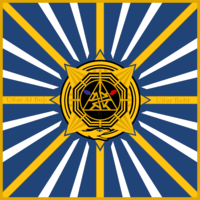 | |
| Country | Benacian Union |
|---|---|
| Founded | 1703 AN |
| Branches | |
| Headquarters | Bastion Ziggurat, Merensk |
| Leadership | |
| Szodan of Benacia | Daniyal ibn Daniyal |
| Commissioner for War | Zacharias Avon-El |
| President of the General Staff Counci | Zacharias Avon-El |
| Manpower | |
| Military age | 15–65 years old |
| Conscription | Wartime only |
| Active personnel | 1,665,001 |
| Reserve personnel | 3,924,670 |
| Deployed personnel | 31,200 (26 rgts) |
| Expenditures | |
| Domestic suppliers | |
| Foreign suppliers | |
The Benacian Union Defence Force is a combined-arms force charged with the territorial defence of the Benacian Union against foreign adversaries as well as the ongoing suppression of partisan rebellions and endemic banditry in the interior regions of Benacia. The BUDF consists of the Land Forces, the Maritime Forces, the Aviation Forces, and the Ransenari Grouping of Forces. The BUDF is also supported by a number of other uniformed services which act as a wartime reserve to the main force, these include the Benacian Labour Reserve, the Corps of the Gentlemen-at-Cudgels, the Women's Auxiliary Service, the Worshipful Guild of the Sacred Carnifices, the Public Forces of Ransenar, the Sovereign League for Defense and Deterrence, the State Guard of Elluenuueq, and the State Guard of the Unified Governorates.
Budget
| Allocated Defence Expenditure | 1705 AN |
|---|---|
| Personnel | 252 |
| Operations & Maintenance | 110 |
| Procurement | 72 |
| Research & Development | 63 |
| Bases, Cantonments & Estates | 61 |
| BUDF Total | 558 |
Personnel, recruitment & training
The peacetime BUDF relies on a combination of voluntary enlistment and purchased apprenticeships to fulfil its manpower requirements. In general terms, recruitment and training across all service branches is done at the brigade/division level, with recruitment being the responsibility of attached the formation's attached commissariat regiment whilst basic training is the responsibility of the formation's inspectorate regiment.
Any male subject of the Benacian continent may enlist with the BUDF for a five year tenure of contracted service from the ages of sixteen to thirty-five. Contracted servicemen may renew their service terms every five years for a further term until they reach the statutory discharge age of sixty-five.
The BUDF supplements voluntary enlistment with the purchase of apprentices at auctions held by the municipal corporations of bailiwicks when boys reach the age of thirteen in Elluenuueq and fifteen in the Unified Governorates. The BUDF maintains a number of retired or invalided captains on half-pay on the condition that they reside in the bailiwicks and organise the local militia and the annual mustering of men eligible for militia service. These serve as liaisons for commissariat recruitment officers when they are touring the governorates in search of their next draft of manpower.
The purchase of apprentices is discretionary but requires the use of legatine authority so as to prevent corrupt and irregular practices at the regimental level.
Once authorised, apprentices purchased for regimental requirements are enlisted on the basis that three years of further education is to be provided in exchange for five years of contracted service, which is then renewable every five years up to the age of sixty-five as with the voluntarily enlisted.
Apprentices are placed into brigade cantonment schools, operated by the inspectorate regiment attached to that formation. The curriculum provided at these schools includes grammar and arithmetic, and political-religious instruction. Those with a demonstrable aptitude are taught fieldcraft, fortification, music and singing, ledger keeping and accounting, the military sciences relevant to land, sea, or air service, or mechanics. Those lacking such talents are instead taught carpentry, blacksmithing, machine-operating, shoemaking and other trades useful to the military.
Whilst apprentices receive the same initial rank (nuïak) as voluntary enlistments, the enlistment bounty is instead deducted as a contribution towards the cost of the apprentice's purchase and the cost of his further education.
Non-commissioned officer training
Commissioned officer selection and training
Further training of the Corps of the Black Legions
Training for the Corps of the Black Legions, followed the pattern established under the Prince of Modan for the discipline of Imperial troops assigned to the Central Banner Group of Benacia Command. Berht Klarænst, known to those passing through it as the "Depot"[1] is situated within an eponymous bailiwick that has been depopulated by the expulsion of the Black Lach. One thing would become apparent from the beginning for new arrivals: officers, non-commissioned officers, and men alike, all went through the same training, leapt or clambered over the same obstacles, learned to handle the same weapons in the most efficient way, and lived the same hard life together.
Those who dedicated themselves to the black banners of the legions swore absolute obedience to their commanders, who in turn sore unquestioning obedience to their commanders and so forth all the way up the chain of command. Soldiers, irrespective of their origins, were forbidden to pillage, steal or molest civilians, accept gifts, have relations with women, eat meat or drink alcohol for the term and duration of their service, except during specified and authorised respite periods. Officers were forced to undergo examinations to assess their familiarity with Kalgachi battle drills, Sanaman Manoeuvreist principles and Shirerithian-Laqi infiltration tactics, largely with the intention of weeding out those lacking in flexibility of thought.
The main objects of legionary training were fourfold: firstly, to produce a spirit of discipline and comradeship, second to none of the armed forces of any power; secondly, to learn the lesson that darkness is a help and not a hindrance; thirdly, to endow the legionary with a degree of physical fitness approaching that of a trained athlete, and at the same time to give him skill in handling all infantry weapons liable to be encountered on the battlefield; and finally – the most consistently reinforced message throughout training to make the legionary eager always to attack as and when opportunity permitted, even – especially – when the odds were not in his favour.
The legionary was expected, and required, to cultivate a spirit of continual aggression that would hold up under any circumstances, fair or foul; moreover, to attain this versatility, the legionary was expected to acquire a mastery of the art of war in all conditions, not only on land, his natural element, even when that land was a precarious foothold on a steep mountain crag, or a tangle of woodland brush and bog sown with dread-nettles and shrapnel-lilies, but also on sea, and, if need be, in the air.
Basic training for all personnel enlisted with the forces under the direct control of Benacia Command is the responsibility of the Inspectorate of Training and Discipline whose primary establishment is located within the Zitadelle of Merensk. Volunteers for the legions, and all personnel assigned to the legions must be volunteers, are normally recruited from amongst the wider pool of personnel maintained by the General Inspectorate, as well as the Aerospace and Maritime Forces maintained by Benacia Command. N&H and ESB paramilitaries are also eligible to volunteer although they, being blessed with their own defined career paths and material comforts, typically tended not to avail themselves of this opportunity.
The physical part of the legionaries training had its impact upon their state of mind. As the days went by and the legionary became able to march faster and still faster for longer and longer distances with heavier and heavier loads until he could cover 15 kilometres in ninety minutes, and 55 kilometres in nine hours, the innate pride born of an awareness of one's own strength took a hold on him. The legionary, spurred on by healthy competitive rivalry with his comrades, became more and more a man apart, as indeed he was by reason of his own conscious decision to join; thus the constant series of physical efforts the legionary undertook were, in and of themselves, an excellent form of mental training.
After basic training was completed the inductees were cycled through three week courses of so-called "spiritual hardening", inspired apparently by the methods and insights of the Urchagin. Those who flunked the course would be cashiered and their records stamped, in green ink, with the initials LMF ("lacking moral fibre") effectively rendering them unemployable upon their return to civilian life anywhere in the territories of the Unified Governorates of Benacia. The motto of the training regime henceforth was that 'Faith and Endurance surpasses Might'. The hardening process began on the first day with trainees forced to line up in files of ten and, at a charge, bayonet a row of live pigs suspended from the rafters before them. Each file would train together, be rewarded together, and be punished together, they were solemnly warned, for the remainder of the three weeks. As an illustration of this the files where any member had baulked at bayoneting a live squealing animal would be denied food and sleep but would be instead assigned to punishment details for the entirety of the rest period while everyone else enjoyed pork stew and a good night's sleep. As first two weeks progressed the trainees were subjected to a barrage of assault courses, long forced marches along wilderness tracks, and competitions where the files were set against one-another to obtain dispensation vouchers for meat and alcohol or else merely to avoid bringing up the rear and being assigned to yet another punishment detail. The final week consisted of tutorials on living off the land, vehicle dismount drills, counter ambush drills, and close quarter combat practice against veteran legionaries dressed up as Laqi bandits. One of the perks for the old-timers was the opportunity to inflict upon the new recruits all the nasty tricks, traps, and humiliations, that had been heaped upon them during their own induction. The concluding action of the week was a bunker clearance drill focusing on oblique angles of approach with use of stealth and concealment, forced entry with demolition charges, room to room clearance with gas grenades and thermite sticks followed by the gunning down of those still standing and the bayoneting of those prostrate on the ground. To add an extra dimension of realism each of the practice bunkers was held and defended by a detachment of surplus protected persons, tethered in place but equipped with riot guns and cudgels, who had been promised their freedom if they successfully survived the drill. None ever did.
At the conclusion of the three weeks each participant was given a week's leave, a pint of grog from the Depot canteen and an enamelled lapel badge featuring a blood-red hand held palm upwards.
The old Imperial practice of targeting minority groups for the purposes of sharpening a unit's blood-lust and improving situational awareness has continued into the present practices of training cohorts, with regular deployments of Fiþn (Troop) sized contingents into Lach infested territory. These raids would be conducted usually via a nighttime "vertical insertion" utilising re-purposed "Walrus" gravimetric transporters escorted by Whirdlebirbs. Once delivered into hostile country, via the hair-raising practice of "grav-tank desant", the troop would be obliged to utilise the time honoured practice in dealing with the Lach and to bring a specified quantity of tongues (including some with the bodies of their owners still attached) to the prearranged extraction point within a set number of hours or days. It should be noted that gravimetric vehicles were gradually superceded by more conventional rotorcraft during the 1680's.
In addition to serving as an introduction to the basics of field craft, these "vaszvaþnur" also helped to thin out the numbers of Black Lach who might otherwise be tempted to filter southwards over the old frontier from Inner Benacia into Upper Lywall.
Since 1686 the Vaszvaþnur has been mostly conducted against recalcitrant and or primitive communities in the Upland Confederation and the Iridian Isles under the guise punitive expeditions to deter or punish banditry and piracy.
Survivors of their first vaszvaþnur received a silver-gilt lapel badge, tastefully depicting a dagger embedded in a Lach skull, a five year service bond of ₦50,000, and a fortnight's leave. As a test of the initiate legionaries initiative, the cohort upon being dismissed would be instructed to reassemble at the end of the fortnight period at a new location, entirely removed from the Depot, anywhere on the Benacian continent. The exact location and time was spelt out. How the recruits would make it to the destination was their own affair. Those who failed to be present and correct on parade at the time and place specified would be returned to the ranks of the General Inspectorate. For the most part the locations would prove to be somewhere absurdly remote and inhospitable within the Raspur Pact's sphere of operations - New Blackstone and Raikoth were popular choices for testing an initiate legionary's ability to organise his own travelling arrangements on the fly. One, somewhat rakish, instructor specified that his recruits were to assemble on the steps of a specific gin house in Shirekeep's entertainments district[2] - which they did, prompting a riot amongst the bar's patrons and obliging the Palatini Corps to send an armoured personnel carrier equipped with a high-pressure water hose in order to quell the disorder.
These excursions, and the subsequent return journey to the Depot, would provide one final opportunity for the instructors to evaluate their charges before the final sifting. By this stage those unable to make the grade ought to have either been flushed out of the system or else solemnly cremated with all due ceremony on a pyre at the edge of the Depot's hinterland of cleared forest. This then, barring mishaps, was the opportunity to pick out candidates for commissioned and non-commissioned officer training, as well as those who might be suited for specialist training in the armoured, aerospace, or maritime arms of the Black Legions.
For those remaining at the end of the sifts however, assignment to the legions awaited. Although the need to replace casualties would sometimes override other considerations, normal practice would be to assign the newly minted legionary to a cohort at some considerable remove from his place of origin.
One of the more unusual aspects of legionary training was the insistence upon each trainee, as a part of his assigned section, tending to an allotted plot of land in which it was their duty to plant, tend, and cultivate a variety of vegetables during their time at the Depot. The purpose for this becomes more clear when the trainees are expected to first clear a patch of the forest adjacent the depot, a forest teeming with deliberately planted urtica terribilis, primula ballistis and lilium discerptionis. For the ordinary legionary it provides an education on how to recognise, avoid, or neutralise the most noxious and fatal reminders of Benacia's legacy of reckless bio-engineering by the Transhumanist foe; for junior officers on the other hand it is an opportunity to contemplate the difficulties inherent in uprooting and containing persistent rhizomic structures.
The other positive was that it kept catering costs for the establishment at Berht Klarænst under control.
Command structure
The Benacian Union Defence Force reports to the High Presidium of the Benacian Union via the Benacian Security Council for strategic and operational matters and the Commission for War for administrative and logistical matters.
It is subjected to ideological discipline, at all levels above the regiment, by units of the General Inspectorate which provides supporting political officers and Mobile Security Troops who served as blocking detachments.
General Staff Council
The General Staff of the Benacian Union Defence Force mirrors closely, for simplicity and interoperability, the pattern set by Benacia Command. Indeed, the Command Executive of Benacia Command, headquartered in Merensk, maintains an interface with the General Staff of the BUDF via a liaison office in Chryse in addition to its political representation on the High Presidium of the Benacian Union.
The Commissioner of Defence, on behalf of the High Presidium, appoints a President of the General Staff Council, who holds the post for four years, and who in turn nominates banner officers to head the three service branches of the BUDF as well as the seven specialist support directorates of the General Staff itself. These officers, all on four year terms similarly, therefore comprise the totality of the General Staff Council.
The seven directorates are as follows:
- D1 - Information Technology
- D2 - Logistics
- D3 - Manpower
- D4 - Planning
- D5 - Operations
- D6 - Military Intelligence
- D7 - Political Relations
The General Staff Council and its supporting directorates, as constituted, therefore are responsibile for operational and strategic level planning, where operational planning covers units and formations above the legion ("Salb") level.
In practice, under most circumstances, operational deployments, including combined arms, joint, and allied operations, would be conducted via the substantially parallel structures of the Benacian Continental Theatre Command of the Raspur Pact, which organises a number of combined arms corps, field armies, and banner groups. Accordingly the foremost concern of the General Staff Council of the BUDF in wartime would be force generation and sustainment.
Personnel selected for assignment to the General Staff Council and its directorates are rebadged and assigned to the General Service Corps so as to detach them from their previous service branch and area of specialism. The General Service Corps, in addition to supporting the General Staff Council also provides the Command and Control Regiments encountered at the corps-level formation and higher.
Branches
Land Forces
Maritime Forces
Aviation Forces
Ransenari Grouping of Forces
The Ransenari Grouping of Forces was established as a branch of the BUDF in 1713 AN so as to receive the balance of manpower transferred from the Grand Army of Ransenar, Navy of Ransenar, and the Riverine Forces of Ransenar after the accession of Ransenar to the Benacian Union in 1711 AN.
Kalgachi Grouping of Forces
Operations
Current missions
Contributions to Raspur Pact theatre commands
| Continental Theatre Command | Material allocation (%) | Lead Nation |
|---|---|---|
| Apollonia Command | 1% | |
| Benacia Command | 98% | |
| Cibola Command | 0% | |
| Keltia Command | 1% | |
| Tapfer Command | 0% | |
| Trans-Euran Command | 0% |
Ongoing operational deployments
Concluded operational deployments
Equipment
Infantry weapons & equipment
| Name | Origin | Type | № in Service | Image | Notes |
|---|---|---|---|---|---|
| Equipment | |||||
| M1699 Mess Tin | Personal Kit | - |  |
||
| M1700 9 Pieces Cooking Set with Burner | Personal Kit | - |  |
||
| M1701 Stainless Steel Coffee Pot | Personal Kit | - |  |
||
| Personal Weapons | |||||
| M1686 assault rifle (7.62×67mmB) | Service rifle | 4,232,627 |  |
| |
| M1690 machine pistol (9x19mm) | Officer or crew side-arm | 442,604 |  |
||
| M1721 battle rifle (7.62×67mmB) | Service rifle | 942,426 / 1,080,000 |  |
||
| Squad Weapons | |||||
| M1703 Wren MK II general purpose machine gun (7.62x67mmB) | General Purpose Machine Gun | 101,205 |  |
||
| Troop Weapons | |||||
| M1591 7.62 mm Rifle | Marksman rifle | 28,000 |
| ||
| M1700 82 mm Recoilless Rifle | Anti-Tank System | 17,660 |  |
||
| Squadron Weapons | |||||
| M1701 14 mm sniper rifle | Sniper Rifle | 8,333 |  |
||
| Malus PLU | Anti-Tank Weapon | 294 | 
|
| |
| Polybolos 12.7 mm HMG | Heavy Machine Gun | 7,090 |  |
||
| Waspsting | Man-portable air-defence system | 157 |
| ||
| Protective Equipment & Body Armour | |||||
| M1639 Stahlhelm | Steel Helmet | 2,335,283 |  |
||
| Pattern M1671 Combat System | Body Armour (inc. M1671 Stahlhelm) |
144,000 sets |  |
Issued to legionary assault cohorts only. | |
| Uniforms | |||||
| Pattern M1717 Service Uniform | Field & Garrison Uniform | - |  |
||
| Pattern M1728 Service Uniform | Field & Garrison Uniform | - |  |
||
Artillery
| Name | Origin | Type | № in Service | Image | Notes |
|---|---|---|---|---|---|
| Towed Artillery | |||||
| M1701 158mm MLRS | 158mm Multiple Rocket Launcher | 7,831 | 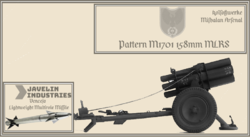 |
||
| HK-VI | 155 mm towed field gun | 5,100 | 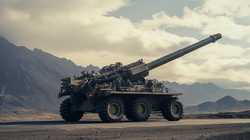 |
| |
| Self-Propelled Artillery | |||||
| HK-III M1675 155 mm mobile gun (wheeled) | Mobile Gun Wheeled 155 mm | 2,627 |  |
| |
| HK-IV 155 mm self-propelled howitzer | 155 mm self-propelled howitzer / field gun |
|
 |
||
| HK-V M1723 203 mm self-propelled howitzer | 203 mm self-propelled howitzer | 1,824 |  |
||
| Anti-Aircraft Artillery / Air Defence Systems | |||||
| M1729 Athena | Short range air defence system | 211 launchers |  |
| |
| Burdock | Long range air defence system | 384 launchers | 
|
| |
| SAI CUTLASS | Medium-range air defence system | 8 |  |
| |
| SAI LONGBOW | Long-range air defence | 4 |  |
| |
| SAI RAPIER | Short-range air defence | 16 |  |
| |
| Silver Hammer | C-RAM | 3 launchers | 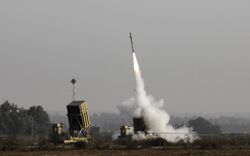 |
||
| System-2 Missile Complex | SAM system / rocket artillery | 146 batteries | |||
| Vulcan Advanced Air Defense System | Directed Energy Air Defence System | 128 / 208 systems |  |
||
| Decommissioned, retired, scrapped | |||||
| M1681 105 mm howitzer | 105mm Howitzer | 2,365 |  |
| |
Land Vehicles
| Name | Origin | Type | № in Service | Image | Notes |
|---|---|---|---|---|---|
| Tanks | |||||
| BK-IX | Heavy tank | 2,000 |  |
||
| BK-X | Medium tank | 4,000 |  |
| |
| BK-XI | Light tank | 8,000 |  |
| |
| Armoured Combat Vehicles | |||||
| BK-XII | Tracked reconnaissance vehicle | 8,000 |  |
| |
| BK-XIII | Infantry fighting vehicle | 12,000 |  |
| |
| HK-IV M1707 Stalker | Anti-Tank Missile Vehicle | 50 |  |
| |
| Rz.Kfz 1714 Razkampfwagen | Mine-Resistant Ambush Protected Vehicle | 4,000 |  |
| |
| Support Vehicles | |||||
| BK-VIII Light Infantry Scout Vehicle | Scout carrier | 67,800 |  |
| |
| Pod Personnel Carrier | Spt Vehicle | 12,424 |  |
| |
| Snatch Land Rover | Spt Vehicle | 271,266 |  |
| |
| Truck, Light | Spt Vehicle | 125,400 |  |
| |
| Truck, Medium | Spt Vehicle | 235 | |||
| Type E 1721 Expedition Truck | Utility vehicle | 3,780 |  |
Assigned to engineering regiments | |
| Type F 1723 Field Sustainment Truck | Fuel tender | 3,540 |  |
Assigned to commissariat regiments | |
| Specialist Vehicles | |||||
| EWV-1 Taran | Electronic warfare vehicle | 2 |  |
||
| GV(MCB)-7 Leviathan | Mobile Command Base | 6 |  |
||
| Große Dampfzugmaschine | Traction Engine | 4,000 |
| ||
| M1679 Detection & Tracking Radar | Mobile air defence radar | 400 |  |
| |
| Decommissioned, retired, or scrapped | |||||
| BK-III Verteidiger | Main Battle Tank | 840 |  |
| |
| BK-IV Bastiat | Armoured Guided Missile Vehicle | 1,136 |  |
| |
| CV-56 Horjin | Multi-Role Armoured Fighting Vehicle | 12,184 |  |
| |
Vessels
| Name | Origin | Type | № in Service | Image | Notes |
|---|---|---|---|---|---|
| Surface combatants | |||||
| Behaurnais-class amphibious assault ship | Amphibious assault ship | 4 |  |
| |
| Carnifex-class cruiser | Cruiser | 1 |  |
||
| Carrillo-class amphibious command ship | Amphibious command ship | 2 |  |
| |
| Cartagena-class | Expeditionary mobile base | 0 / 1 |  |
Order placed 1730 AN | |
| Coastal Patrol Boat | Patrol | 109 |  |
| |
| Dredger-class gunboat | Gunboat | 9 |  |
Order placed 1723 AN. | |
| Ignatius-class | Amphibious transport dock | 0 / 10 |  |
| |
| Manco Cápac-class cruiser | Frigate | 40 / 120 |  |
Order placed 1720 AN. | |
| Melusine II-class | Fast attack craft | 60 |  |
| |
| Montran-class | Destroyer | 7 |  |
| |
| Protector-class missile frigate | Missile frigate | 16 |  |
| |
| Rhodondra-class amphibious assault ship | Amphibious assault ship | 7 |  |
| |
| Rose-class corvette | Corvette | 3 / 11 |  |
||
| Seafox-class corvette | Corvette | 36 |  |
| |
| Thorn-class sloop | Sloop | 3 | 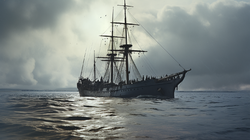 |
||
| Trwyth-class | Aircraft carrier (riverine) | 1 |  |
Attached to Riverine Fleet of the Maritime Forces of the Benacian Union (River Elwynn). | |
| Support vessels | |||||
| Logistic Support Vessel | Fleet auxiliary | 27 |  |
| |
| Submarines | |||||
| Type XXV U-Boat | Attack Submarine | 16 |  |
| |
| Type XXVI U-Boat | Nuclear-powered Cruise Missile Submarine | 1 |
| ||
| Type XXVII U-Boat | Fleet submarine | 6 |  |
| |
| Type XXVIII U-Boat | Nuclear-powered Attack Submarine | 1 |  |
| |
| Type XXIX | Diesel-electric U-boat | 2 |  |
Ordered, 1730 AN | |
| Type XXX | Diesel-electric U-boat | 2 |  |
Ordered, 1730 AN | |
| Decommissioned | |||||
| Viviantia-class logistic support vessel | Fleet Auxiliary | 6 |  |
| |
| Florimell-class Troop Landing Ship | Fleet Auxiliary | 393 | Transferred to Benacian Merchant Marine, XIII.1720 AN. | ||
Aircraft
Aircraft are formed into numbered aviation regiments of 240x aircraft each, and numbered squadrons named by type where the numbers are insufficient for a full aviation regiment.
| Name | Origin | Type | № in Service | Image | Notes |
|---|---|---|---|---|---|
| Capital Ship | |||||
| Dominion-class | Gravnought | 1 |  |
| |
| Combat Air | |||||
| A-7 Astil | Ground attack aircraft | 0 / 1,582 |  |
||
| F-9 Ashavan III | Multi-role Strike Fighter | 1,200 |  |
||
| F-17 Axarana | Stealth Air Superiority Fighter | 115 |  |
| |
| F-18 Cyclone | Strategic deep-strike fighter | 114 |  |
Prototypes received from Ransenar, 1712 AN | |
| F-24 Lightning | Multi-role fighter | 36 / 108 |  |
| |
| Intelligence, Surveillance, Target Acquisition and Reconnaissance | |||||
| AEW-1 Floret |
|
Airborne Early Warning Aircraft | 6 |  |
|
| AEW-1 Buscadora | Airborne Early Warning | 5 |  |
| |
| Javelin M-2 Dragoon | UAV | 60 |  |
||
| P-2 Navegador | Air Policing / Maritime Patrol | 24 |  |
||
| P-3 Bailiff | Rural Policing / Patrol | 16 |  |
| |
| VT-UAV 1 Tadpole | Unmanned Aerial Reconnaissance Vehicle | 669 |  |
||
| Air Mobility | |||||
| GAV-4(U) Jackalope | Transport Utility | 754 |  |
| |
| TR-279 Dront | VTOL Transport | 96 |  |
||
| Helicopters | |||||
| AH-75 Cobra | Attack Helicopter | 42 | 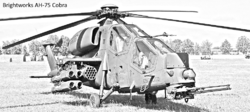 |
||
| CH-276 Camel | Utility Transport | 88 |  |
||
| K-2 Whirdlebird | Utility Helicopter | 566 |  |
| |
| R-2 Krähenwürger | Heavy Assault Rotorcraft | 146 |  |
||
| NH-76 Dromosker | ASW Patrol | 272 |  |
||
| UH-76 Dromosker | Utility Transport | 142 |  |
||
| Training | |||||
| T-4/A-4 Flecha | Training/Light Attack | 120 |  |
||
| T-5/A-5 Tejón de Miel | Training/Light Attack | 40 |  |
||
| T-6 Preceptora | Trainer | 120 |  |
||
| Decommissioned, retired, scrapped | |||||
| B-67 Shahrukh | Strategic Bomber | 66 |  |
| |
| F-9 Ashavan II | Multi-role Strike Fighter | 525 |  |
| |
| GAV(P)-6 Zephyr Mark 1a | Patrol | 51 |  |
Retired for lack of components and placed into storage pending return to the Natopian Defense Force, 1714 AN. | |
Missiles / Guided Munitions / Loitering Munitions
| Name | Origin | Type | № in Service | Image | Notes |
|---|---|---|---|---|---|
| Air-to-Air | |||||
| AAM-2 Sonderbotschaft | 13,023 | ||||
| S-2/A | 1,667 |  |
|||
| Air-to-Ground | |||||
| S-2/A(S) | 416 |  |
|||
| Ground-to-Air | |||||
| SA-1 Red Mist | Air defence missile | 392 |
| ||
| S-2/S(A) | 6,668 |  |
|||
| Ground-to-Ground | |||||
| F-11GM Florentine | Guided Munition (Piloted) | 5,940 |
| ||
| M1728 Jägare-sökargranat | Loitering munition (FPV drone) | 4,990 |  |
| |
| S-2/S | 2,083 |  |
|||
| Maritime | |||||
| S-2/N | 2,604 |  |
|||
| Short & Medium Range Ballistic | |||||
| S-3 Schlächter | Intermediate-range Ballistic Missile | 3,840 |  |
16x Ballistic Missile Regiments assigned to fixed launch sites | |
Ranks, Insignia, Uniforms & Wages
| Grade | Insignia | RP Rank Code | Rank | Pay |
|---|---|---|---|---|
| Chiefs of Staff (4.0) |
 |
OF-10 |
|
|
| General Officers (3.0) |
 |
OF-9 |
|
|
 |
OF-8 |
|
Combined Officer Pay x8 | |
 |
OF-7 |
|
Combined Officer Pay x7 | |
 |
OF-6 |
|
Combined Officer Pay x6 | |
| Senior Officers (2.1) |
 |
OF-5 |
|
Combined Officer Pay x5 |
 |
OF-4 |
|
Combined Officer Pay x4 | |
 |
OF-3 | Ahmst Mairstranin | Combined Officer Pay x3 | |
| Junior Officers (2.2) |
 |
OF-2 | Fiþnan | Combined Officer Pay x2 |
 |
OF-1 | Golsapbir | ||
 |
OF(C) | Silbir | ||
| Non-Commissioned Officers (1.1) |
File:BUDF Grade 1.1.png | OR-9 | Ænst Opratzan | Basic rate of pay x9 |
| OR-8 | Opratzan | Basic rate of pay x8 | ||
| OR-7 | Ahtaldan | Basic rate of pay x7 | ||
| OR-6 | Tzæknak | Basic rate of pay x6 | ||
| OR-5 | Frum | Basic rate of pay x5 | ||
| Enlisted Men (1.2) |
File:BUDF Grade 1.2.png | OR-4 | Usczosoþ Streïak | Basic rate of pay x4 |
| OR-3 |
|
Basic rate of pay x3 | ||
| OR-2 |
|
Basic rate of pay x2 | ||
| OR-1 |
|
Rations, welfare and other miscellanea
The basic ration provision for personnel in the BUDF derive from three entitlements extended to all servicemen by order of the High Presidium of the Benacian Union in 1706 AN. These are as follows:
- Basic Ration:– milk (4l), eggs (6x), meat (150g), butter (50g), margarine (50g), edible oil, tea, cheese (30g), sugar (100g), jam (50g). Available via weekly allocations to all subjects in amounts specified, subject to availability.
- Government & Guild Service Ration:– bread (800g), eggs (1x), meat (230g), butter (50g), margarine (50g), edible oil, coffee, cheese (50g), sugar (225g), jam (60g). Supplementary weekly ration available to employees of the High Presidium of the Benacian Union, the Benacian Union Defence Force, and the civil executives, or else to workers employed by companies affiliated to guilds recognised by the Chamber of Guilds and Corporations.
- Field & Industrial Service Ration:– bread (80g), water-biscuit (20g), processed meat (150g), coffee or tea, sugar, salt, rum (1 pint). Supplementary daily ration issued to personnel engaged in intensive or arduous labours. Distributed directly to recipients in situ via appropriate means. Deployed personnel receive the Field & Industrial Service Ration consisting of tinned meat and foil sealed packets carrying the Superabundance Foods brand mark. The exception of course is the rum ration, which is brought forward by runners seconded for the task from Benacian Labour Reserve.
In 1716 AN, following serious outbreaks of scurvy amongst personnel garrisoned in the Warring Islands, a daily citrus juice ration was introduced for all BUDF personnel.
See also
Notes and references
- ^ Named in the Minarborian era for one Clarence Etzeterra, mechanically-augmented lich and father of Mondo. The ironic implications of training for a vernichtungskrieg against Benacian transhumanity in a venue named for a noted specimen of the latter has doubtless popularised the "Depot" designation as an more ideologically-palatable alternative.
- ^ It was subsequently discovered that the establishment had reminded this particular instructor of his overdue bar tab once too often.
- ^ 1,783.10 Natopian natopos
- ^ 26,746.5 Natopian natopos
